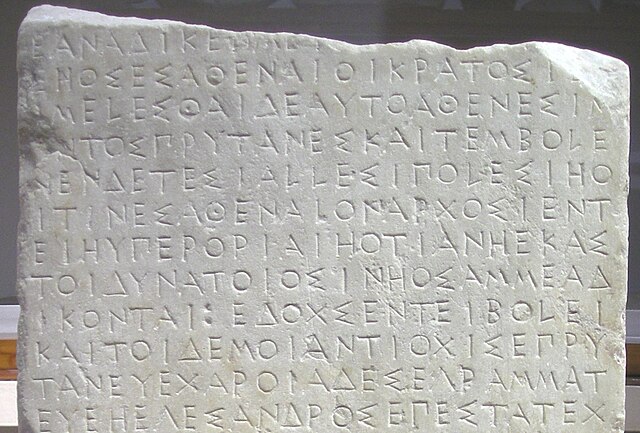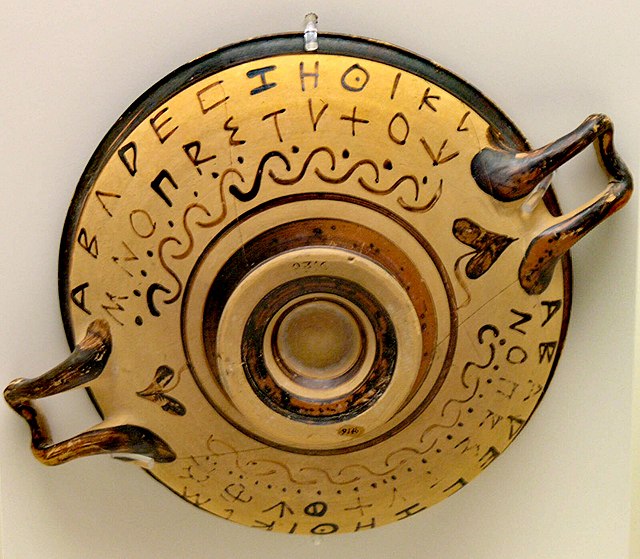Digamma or wau is an archaic letter of the Greek alphabet. It originally stood for the sound but it has remained in use principally as a Greek numeral for 6. Whereas it was originally called waw or wau, its most common appellation in classical Greek is digamma; as a numeral, it was called episēmon during the Byzantine era and is now known as stigma after the Byzantine ligature combining σ-τ as ϛ.
Ancient Greek ceramic fragment depicting a horse with rider. The inscription reads [...]Ι ϜΑΝΑΚΤΙ ([...]i wanakti), "to the king", with an initial digamma (and a local Σ-shaped form for iota).
The alphabet on a black figure vessel, with a square-C digamma.
A fragment of Papyrus 115, showing the number "χιϛ" (616, the "Number of the Beast"), with a C-shaped digamma.
Many local variants of the Greek alphabet were employed in ancient Greece during the archaic and early classical periods, until around 400 BC, when they were replaced by the classical 24-letter alphabet that is the standard today. All forms of the Greek alphabet were originally based on the shared inventory of the 22 symbols of the Phoenician alphabet, with the exception of the letter Samekh, whose Greek counterpart Xi (Ξ) was used only in a sub-group of Greek alphabets, and with the common addition of Upsilon (Υ) for the vowel. The local, so-called epichoric, alphabets differed in many ways: in the use of the consonant symbols Χ, Φ and Ψ; in the use of the innovative long vowel letters, in the absence or presence of Η in its original consonant function ; in the use or non-use of certain archaic letters ; and in many details of the individual shapes of each letter. The system now familiar as the standard 24-letter Greek alphabet was originally the regional variant of the Ionian cities in Anatolia. It was officially adopted in Athens in 403 BC and in most of the rest of the Greek world by the middle of the 4th century BC.

The phrase Ἔδοξεν τῇ Βουλῇ καὶ τῷ Δήμῳ ("The Council and the Citizens have decided") is typically spelled Εδοχσεν τει Βολει και τοι Δεμοι in inscriptions of the Athenian democracy prior to 403 BC.
Corinthian black-figure column-krater, showing the name ΗΙΠΠΟΛΥΤΟΣ (Hippolytos) in Corinthian script.

![Ancient Greek ceramic fragment depicting a horse with rider. The inscription reads [...]Ι ϜΑΝΑΚΤΙ ([...]i wanakti), "to the king", with an initial dig](https://upload.wikimedia.org/wikipedia/commons/thumb/2/2e/Ceramic_fragment_with_WANAKTI_inscription.jpg/640px-Ceramic_fragment_with_WANAKTI_inscription.jpg)



